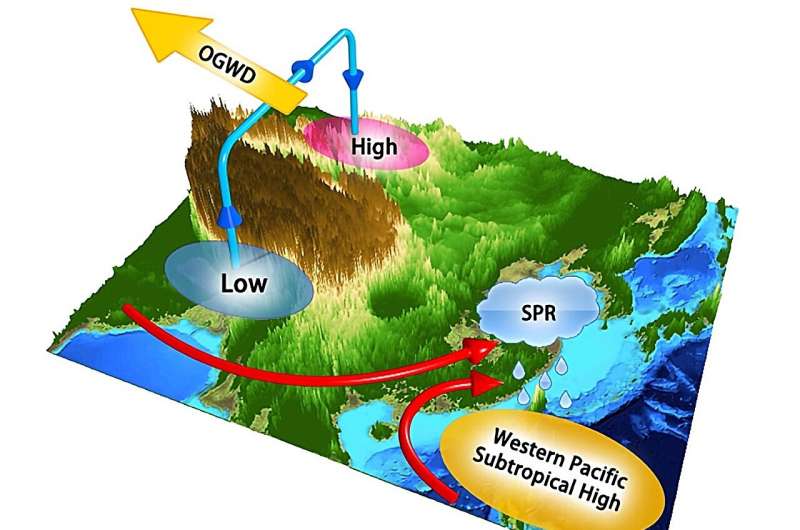Gravity waves caused by complex terrain over the Tibetan Plateau can enhance the intensity of spring rainfall
The springtime persistent rainfall is the major rainy period before the onset of summer monsoon in East Asia. For example, it accounts for about 35% of the annual precipitation in South China, which brings plentiful water for agricultural and industrial use but can also cause heavy rainfall and flash flooding.
According to Xin Xu, an associate professor at Nanjing University, “Previous studies demonstrated great importance of the mechanical and thermal effects of the Tibetan Plateau large-scale orography on the formation of springtime persistent rainfall. However, the impact of small-scale orography over the Tibetan Plateau remains poorly understood.”
The team finds that the orographic gravity waves triggered by small-scale orography over the Tibetan Plateau contribute importantly to the spring rainfall in East Asia. The impact is even comparable to that of surface sensible heating of the Tibetan Plateau’s large-scale orography.
The breaking of orographic gravity waves induces a zonal wave drag in the middle troposphere, which destroys the geostrophic balance of the large-scale westerly flow and thus drives a geostrophic meridional circulation across the Tibetan Plateau. The rising branch of the meridional circulation acts to lower the pressure and increase the meridional pressure gradient to the south of the Tibetan Plateau by dynamically pumping the lower-tropospheric air upwards.
Consequently, the southwesterly monsoonal flow on the southeastern flank of the Tibetan Plateau intensifies and transports more water vapor to East Asia, resulting in an enhancement of the springtime persistent rainfall.
This study proposes a new type of air pump, which is an analogy of the well-known thermal sensible heating air pump (i.e., SHAP) but driven dynamically by the orographic gravity wave drag over the Tibetan Plateau. It helps more completely understand the climatic effects of the Tibetan Plateau’s multiscale orography and provides a new perspective on the westerly-monsoon synergy in East Asia.
The study is published in the journal Science China Earth Sciences.
More information:
Runqiu Li et al, Importance of orographic gravity waves over the Tibetan Plateau on the spring rainfall in East Asia, Science China Earth Sciences (2023). DOI: 10.1007/s11430-023-1204-6
Citation:
Gravity waves caused by complex terrain over the Tibetan Plateau can enhance the intensity of spring rainfall (2024, March 12)
retrieved 18 March 2024
from https://phys.org/news/2024-03-gravity-complex-terrain-tibetan-plateau.html
This document is subject to copyright. Apart from any fair dealing for the purpose of private study or research, no
part may be reproduced without the written permission. The content is provided for information purposes only.

The springtime persistent rainfall is the major rainy period before the onset of summer monsoon in East Asia. For example, it accounts for about 35% of the annual precipitation in South China, which brings plentiful water for agricultural and industrial use but can also cause heavy rainfall and flash flooding.
According to Xin Xu, an associate professor at Nanjing University, “Previous studies demonstrated great importance of the mechanical and thermal effects of the Tibetan Plateau large-scale orography on the formation of springtime persistent rainfall. However, the impact of small-scale orography over the Tibetan Plateau remains poorly understood.”
The team finds that the orographic gravity waves triggered by small-scale orography over the Tibetan Plateau contribute importantly to the spring rainfall in East Asia. The impact is even comparable to that of surface sensible heating of the Tibetan Plateau’s large-scale orography.
The breaking of orographic gravity waves induces a zonal wave drag in the middle troposphere, which destroys the geostrophic balance of the large-scale westerly flow and thus drives a geostrophic meridional circulation across the Tibetan Plateau. The rising branch of the meridional circulation acts to lower the pressure and increase the meridional pressure gradient to the south of the Tibetan Plateau by dynamically pumping the lower-tropospheric air upwards.
Consequently, the southwesterly monsoonal flow on the southeastern flank of the Tibetan Plateau intensifies and transports more water vapor to East Asia, resulting in an enhancement of the springtime persistent rainfall.
This study proposes a new type of air pump, which is an analogy of the well-known thermal sensible heating air pump (i.e., SHAP) but driven dynamically by the orographic gravity wave drag over the Tibetan Plateau. It helps more completely understand the climatic effects of the Tibetan Plateau’s multiscale orography and provides a new perspective on the westerly-monsoon synergy in East Asia.
The study is published in the journal Science China Earth Sciences.
More information:
Runqiu Li et al, Importance of orographic gravity waves over the Tibetan Plateau on the spring rainfall in East Asia, Science China Earth Sciences (2023). DOI: 10.1007/s11430-023-1204-6
Citation:
Gravity waves caused by complex terrain over the Tibetan Plateau can enhance the intensity of spring rainfall (2024, March 12)
retrieved 18 March 2024
from https://phys.org/news/2024-03-gravity-complex-terrain-tibetan-plateau.html
This document is subject to copyright. Apart from any fair dealing for the purpose of private study or research, no
part may be reproduced without the written permission. The content is provided for information purposes only.
